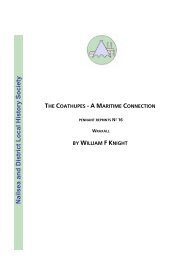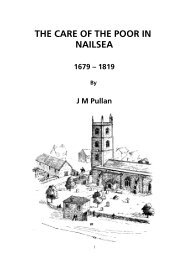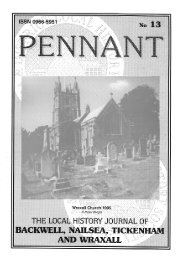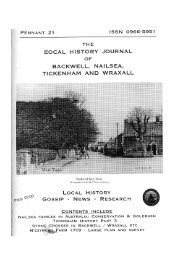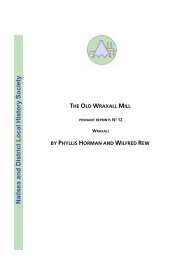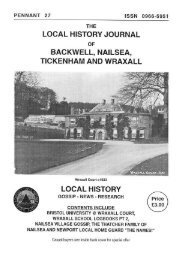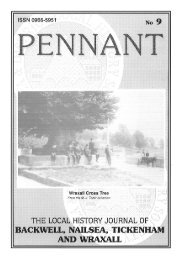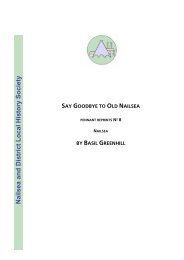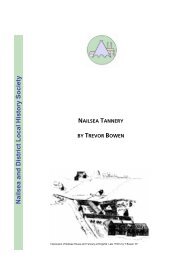Here - Nailsea and District Local History Society
Here - Nailsea and District Local History Society
Here - Nailsea and District Local History Society
You also want an ePaper? Increase the reach of your titles
YUMPU automatically turns print PDFs into web optimized ePapers that Google loves.
elieved to be the first Quaker Meeting House in North Somerset st<strong>and</strong>s on the formervillage green which was bounded by North Street, Watery Lane (where you now st<strong>and</strong>)<strong>and</strong> Kingshill.13. Tudor House on the corner of Watery Lane <strong>and</strong> Kingshill was the Bird in the H<strong>and</strong>public house between 1902-1966. Look opposite <strong>and</strong> you will see.14. Two modern houses. This site was the Tannery between 1696 <strong>and</strong> 1890. It suppliedleather to a flourishing boot, clog <strong>and</strong> shoe cottage industry centred around Kingshill <strong>and</strong>Silver Street in the 1800s. Take a left turn along a track <strong>and</strong> public footpath around a highwall.15. <strong>Here</strong> is <strong>Nailsea</strong> House. You can see through the gates one of the milestonesexcavated from the Tannery. Walk a few yards on <strong>and</strong>16. Look through the gates of Old Kingshill Court - you can just see the chimney <strong>and</strong> whitegable wall of Old Kingshill Farm House beyond the trees. When its thatched roof wasreplaced a receipt was found possibly indicating that some of Cromwell's CommonwealthTroops lodged here in 1643. Retrace your steps to Kingshill <strong>and</strong> cross the road. Look outfor a footpath alongside No.18.17. On this corner was the Poors House used as such until 1871.18. Continue down the footpath, past the site of Kinghill Pit (c.1800-1820) <strong>and</strong> into ChapelBarton.19. Opposite is reputedly the first Wesleyan Methodist Chapel in North Somerset built in1792. Now extended as the <strong>Nailsea</strong> Social Club, much of its early congregation heredrawn from the families of coal miners <strong>and</strong> glassworkers. Turn right until you get to the20. Moorend Spout Public House (formerly the Butchers Arms c.1735). If you wish toextend your walk at this point see * at the end otherwise return along Union Street. Alongthe way look out for21. Early Council Houses named Forty Fathoms after the coal pit which operated hereuntil 1830.*The Extended WalkThis route will take you along unmade footpaths <strong>and</strong> suitable footwear is recommended.From the Moorend Spout Public House continue along North Street <strong>and</strong> turn right into FirLeaze, then left into North Lane. Note the tall cottage which was converted from a collieryengine house. Turn left at the Public Footpath sign <strong>and</strong> follow the public right of waythrough the garden of No.8 respecting the owner's privacy. Continue through the orchardkeeping to the conifer hedge <strong>and</strong> cross the Parish Brook via the stone style. Follow thebrook to the right to emerge on The Causeway. Note the long, narrow strip of l<strong>and</strong> to yourleft, purchased for a canal to serve the coal mines <strong>and</strong> glass works but never built.Causeway House on your left <strong>and</strong> take the public footpath on the right skirting the edge ofthe stables. Cross the brook via the stile <strong>and</strong> then via a further field to another stile <strong>and</strong>Causeway View. Cross over the road <strong>and</strong> continue via the footpath to rejoin the shortertrail at Old Kingshill Court <strong>and</strong> <strong>Nailsea</strong> House.



